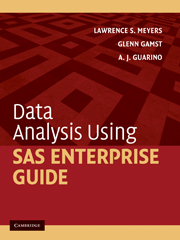Book contents
- Frontmatter
- Contents
- Preface
- Acknowledgments
- I Introducing SAS Enterprise Guide
- II Performing Analyses and Viewing Output
- III Manipulating Data
- IV Describing Data
- V Score Distribution Assumptions
- VI Correlation and Prediction
- VII Comparing Means: The t Test
- VIII Comparing Means: ANOVA
- IX Nonparametric Procedures
- X Advanced ANOVA Techniques
- 30 One-Way Between-Subjects Analysis of Covariance
- 31 One-Way Between-Subjects Multivariate Analysis of Variance
- XI Analysis of Structure
- References
- Author Index
- Subject Index
30 - One-Way Between-Subjects Analysis of Covariance
Published online by Cambridge University Press: 05 June 2012
- Frontmatter
- Contents
- Preface
- Acknowledgments
- I Introducing SAS Enterprise Guide
- II Performing Analyses and Viewing Output
- III Manipulating Data
- IV Describing Data
- V Score Distribution Assumptions
- VI Correlation and Prediction
- VII Comparing Means: The t Test
- VIII Comparing Means: ANOVA
- IX Nonparametric Procedures
- X Advanced ANOVA Techniques
- 30 One-Way Between-Subjects Analysis of Covariance
- 31 One-Way Between-Subjects Multivariate Analysis of Variance
- XI Analysis of Structure
- References
- Author Index
- Subject Index
Summary
Overview
Analysis of covariance (ANCOVA) allows us to statistically control for a variable that potentially exerts an effect on the dependent variable but was not part of or could not readily be incorporated into the experimental design as an independent variable. Using ANCOVA, we bring that variable into the data analysis as a covariate. By collecting measures of a variable on the study participants and then treating it as a covariate in the analysis, it is possible to statistically “remove” or “neutralize” its effect on the dependent variable prior to determining the effects of the independent variable on the dependent variable. This allows us to evaluate the effects of the independent variable with the influence of the covariate removed. More complete descriptions of this analysis can be found in Gamst et al. (2008), Kirk (1995), and Maxwell and Delaney (2000).
There are three steps that are involved in performing an ANCOVA.
First, we use the covariate to predict the dependent variable. This is accomplished through a linear regression procedure.
Second, we adjust the values of the dependent variable to remove the effects of the covariate. That is, the regression model uses the scores on the covariate to predict the observed scores on the dependent variable. At the completion of the regression procedure, each case in the data set has a predicted dependent variable score.
- Type
- Chapter
- Information
- Data Analysis Using SAS Enterprise Guide , pp. 299 - 312Publisher: Cambridge University PressPrint publication year: 2009



